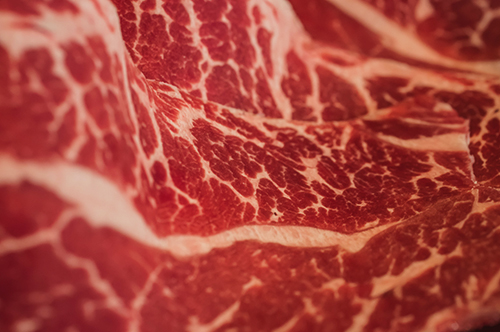Is Red Meat Bad for You, or Good? An Objective Look

This article was written by Kris Gunnars, BSc on May 22, 2018. This article was originally published on https://www.healthline.com/nutrition/is-red-meat-bad-for-you-or-good
Red meat is the meat of mammals, which is normally red when raw.
It’s one of the most controversial foods in the history of nutrition.
Although humans have been eating it throughout evolution, many people believe it can cause harm.
Below is a review of the evidence on the health effects of red meat. The article does not tackle ethical and environmental issues.
Today’s Meat Isn’t What It Used to Be
 People have been eating meat throughout evolution and have digestive systems well equipped to handle it.
People have been eating meat throughout evolution and have digestive systems well equipped to handle it.
Traditional populations like the Masai have eaten much more red meat than the average Westerner but remained in excellent health (1).
However, the meat consumed today is different than the meat people ate in the past. Back in the day, animals roamed free and ate grass, insects or other foods natural to them.
Picture a wild cow on a field 10,000 years ago, roaming free and chewing on grass and various other edible plants.
The meat from this animal is different than the meat derived from a cow that was born and raised in a factory, fed grain-based feed and given growth-promoting hormones and antibiotics.
Today, some meat products are highly processed after the animals have been slaughtered. They are smoked, cured, then treated with nitrates, preservatives and various chemicals.
Therefore, it is very important to distinguish between different types of meat:
- Processed meat: These products are usually from conventionally raised cows, then go through various processing methods. Examples include sausages and bacon.
- Conventional red meat: Conventional red meats are fairly unprocessed, but the cows are usually factory farmed. Meats that are red when raw are defined as red meats. This includes lamb, beef, pork and some others.
- White meat: Meats that are white when cooked are defined as white meats. This includes meat from poultry like chicken and turkey.
- Grass-fed, organic meat: This meat comes from animals that have been naturally fed and raised organically, without drugs and hormones. They also don’t have any artificial chemicals added.
When examining the health effects of meat, it’s important to realize that not all meat is created equal.
Many studies on red meat, especially those conducted in the US, primarily examine meat from factory-farmed animals that have been fed grain-based feeds.
Summary: It’s important to make a distinction between different kinds of meat. For example, grass-fed and organic meat is nutritionally different than factory-farmed, processed meat.
Red Meat Is Very Nutritious
Red meat is one of the most nutritious foods you can eat.
It is loaded with vitamins, minerals, antioxidants and various other nutrients that can have profound effects on health.
A 3.5-ounce (100-gram) portion of raw ground beef (10% fat) contains (2):
- Vitamin B3 (niacin): 25% of the RDA
- Vitamin B12 (cobalamin): 37% of the RDA (this vitamin is unattainable from plant foods)
- Vitamin B6 (pyridoxine): 18% of the RDA
- Iron: 12% of the RDA (this is high-quality heme iron, which is absorbed much better than iron from plants)
- Zinc: 32% of the RDA
- Selenium: 24% of the RDA
- Plenty of other vitamins and minerals in smaller amounts
This comes with a calorie count of 176, with 20 grams of quality animal protein and 10 grams of fat.
Red meat is also rich in important nutrients like creatine and carnosine. Non-meat eaters are often low in these nutrients, which may potentially affect muscle and brain function (3, 4, 5).
Grass-fed beef is even more nutritious than grain-fed beef, containing plenty of heart-healthy omega-3s, the fatty acid CLA and higher amounts of vitamins A and E (6, 7, 8).
Summary: Red meat is very nutritious, especially if it comes from animals that have been naturally fed and raised. It’s a great source of protein, iron, B12, zinc, creatine and various other nutrients.
Heart Disease, Diabetes and Death
The effects of red meat on health have been well studied.
However, most of these studies are so-called observational studies, which are designed to detect associations but cannot prove causation.
Several observational studies show that red meat is associated with a greater risk of cardiovascular disease, cancer and death (9).
Nevertheless, not all red meat has the same health effects.
A massive review of 20 studies including 1,218,380 individuals found that processed meat was associated with an increased risk of heart disease and diabetes. However, no association was found for unprocessed red meat (10).
In the EPIC study, a very large observational study including 448,568 people, processed meat increased the risk of death, while no effect was seen for unprocessed red meat (11).
When it comes to an increased risk of heart disease, diabetes and death, it’s crucial to distinguish between processed and unprocessed meat, as the two can have vastly different effects.
The observational studies seem to agree that processed meat (not unprocessed red meat) is associated with an increased risk of an early death and many diseases.
But even so, it’s important to keep in mind that these studies have limitations. It’s impossible to draw strong conclusions from observational studies.
The only way to establish cause and effect is to perform randomized controlled trials.
Summary: Some observational studies show a link between meat intake, diabetes, heart disease and death. Other studies suggest this only applies to processed meat, not unprocessed red meat.
Does Red Meat Increase Your Risk of Cancer?
 Many observational studies show that red meat consumption is associated with an increased risk of cancer (12, 13, 14).
Many observational studies show that red meat consumption is associated with an increased risk of cancer (12, 13, 14).
The main type of cancer that red meat is believed to cause is colorectal cancer, the fourth most commonly diagnosed cancer in the world.
A recurrent problem in these studies is that they seem to pool together processed meat and unprocessed red meat.
Meta-analyses in which researchers analyze data from many studies show that the increased risk of colorectal cancer is very low. One meta-analysis found a weak effect for men, but no effect for women (15, 16).
Other studies suggest that it’s not the meat itself, but rather harmful compounds that form when the meat is cooked, that contribute to the increased risk (17, 18).
Therefore, the cooking method may be a major determinant of the ultimate health effects of meat.
Summary: Several observational studies show that red meat eaters are at a greater risk of cancer, but larger reviews looking at the evidence as a whole show that the effect is weak and inconsistent.
Correlation Does Not Equal Causation
When you look closely, practically all studies that allegedly prove that red meat causes harm are observational studies.
These types of studies can only demonstrate correlation, or that two variables are associated.
They can tell us that individuals who eat a lot of red meat are more likely to get sick, but they cannot prove that red meat is the cause.
One of the main problems with such studies is that they are plagued by various confounding factors.
For example, people who eat red meat are less health-conscious and more likely to smoke, drink excessively, eat more sugar, exercise less, etc.
People who are health-conscious behave very differently than people who are not, and it’s impossible to correct for all of these factors.
Another problem with observational studies is that they’re usually based on food frequency questionnaires, in which people are expected to remember what they ate in the past.
It’s always a bad idea to make health decisions based on observational studies alone. There are many cases in history where randomized controlled trials ended up showing the exact opposite effect.
For example, the Nurses’ Health Study once showed that estrogen replacement therapy helped reduce heart disease in women. Later, a randomized controlled trial discovered that it actually increases the risk (19).
Summary: Observational studies cannot be used to determine cause and effect. There are many confounders in such studies, and higher-quality studies sometimes end up showing the exact opposite effect.
A Look at Some Randomized Controlled Trials
Randomized controlled trials are the gold standard of science.
In these studies, people are randomized into groups. For example, one group eats diet A, while the other group eats diet B.
Then the researchers follow the people and see which diet is more likely to lead to a particular outcome.
Several randomized controlled trials have examined the health effects of red meat directly.
A few studies investigated the effects of red meat on risk factors for heart disease.
One review of controlled studies concluded that eating half a serving or more of red meat daily doesn’t adversely affect heart disease risk factors such as blood lipids and blood pressure (20).
Another review showed that lean, unprocessed beef doesn’t negatively affect people’s blood lipids, compared to poultry or fish (21).
As a rich protein source, red meat can also benefit muscle growth in people doing strength exercises.
A study in older women showed that eating 160 grams of red meat six days of the week for four months enhanced muscle growth resulting from strength training, compared to pasta or rice (22).
Red meat also decreased the levels of the inflammatory marker IL-6 (22).
Keep in mind that all of these studies examined lean red meat. To date, no studies have examined the health effects of high-fat red meat.
However, there are plenty of studies that compare high-fat diets with low-fat diets.
These studies have the primary goal of reducing saturated fat, which means that the people in them have to eat less red and processed meats, which happen to be high in saturated fat.
The Women’s Health Initiative was a study in over 46,000 women. One group was instructed to eat a low-fat diet, while the other group continued eating the standard Western diet.
After a period of 7.5 years, there was almost no difference (only 1 lb/0.4 kg) in weight between groups. There was also no difference in the rate of heart disease or cancer (23, 24, 25, 26).
One randomized controlled trial compared the Atkins diet (high in red meat) to the Ornish diet (a low-fat vegetarian diet with no red meat). It is called the A to Z weight loss study (27).
After one year, the Atkins group had lost more weight and had greater improvements in some of the most important risk factors for disease.
Many other studies compared low-carb (high in red meat) and low-fat (low in red meat) diets. In these studies, low-carb diets lead to much better health outcomes (28, 29, 30).
Taken together, these studies suggest unprocessed red meat doesn’t adversely affect health and may even have benefits.
However, more studies need to examine whether it affects hard endpoints like heart disease and cancer. The roles of cooking methods and processing techniques also need to be studied further.
Summary: Several randomized controlled trials indicate that the intake of unprocessed red meat does not have negative health effects. It may even have benefits.
Red Meat Optimization 101
 When meat is cooked at a high temperature, it can form harmful compounds.
When meat is cooked at a high temperature, it can form harmful compounds.
These include heterocyclic amines (HAs), polycyclic aromatic hydrocarbons (PAHs) and advanced glycation end-products (AGEs).
These substances can cause cancer in animals.
If meat really raises your risk of cancer, which has yet to be proven, this may be the reason (31, 32, 33).
But this doesn’t only apply to meat, other foods can also form harmful compounds when heated excessively.
Here are some tips to ensure your meat doesn’t form these harmful substances:
- Use gentler cooking methods like stewing and steaming instead of grilling and frying.
- Minimize cooking at high heats and never expose your meat to a flame.
- Do not eat charred and/or smoked food. If your meat is burnt, cut away the charred pieces.
- If you marinate your meat in garlic, red wine, lemon juice or olive oil, it can reduce HAs significantly.
- If you must cook at a high heat, flip your meat frequently to prevent it from burning.
Many people love the taste of fried and grilled meat. But if you want to enjoy meat and receive the full benefits without any of the potentially harmful consequences, use gentler cooking methods and avoid burnt meat.
Summary: To prevent the formation of harmful substances when cooking meat, choose gentler cooking methods and avoid burning your meat.
The Bottom Line
When you look past the scare tactics and sensationalist headlines, you realize that there is no strong evidence linking red meat to disease in humans.
There are only observational studies, which often don’t distinguish between red meat and processed meat.
They also rely on food frequency questionnaires and simply cannot account for complicated confounding factors like health consciousness.
Observational studies provide hints and are useful for generating theories, but they cannot test them.
As long as you choose unprocessed and preferably grass-fed red meat, make sure to use gentler cooking methods and avoid burnt/charred pieces, there probably is nothing to worry about.
Properly cooked red meat is likely very healthy.
It’s highly nutritious and loaded with healthy proteins, healthy fats, vitamins and minerals, along with various nutrients known to positively affect the function of both your body and brain.
